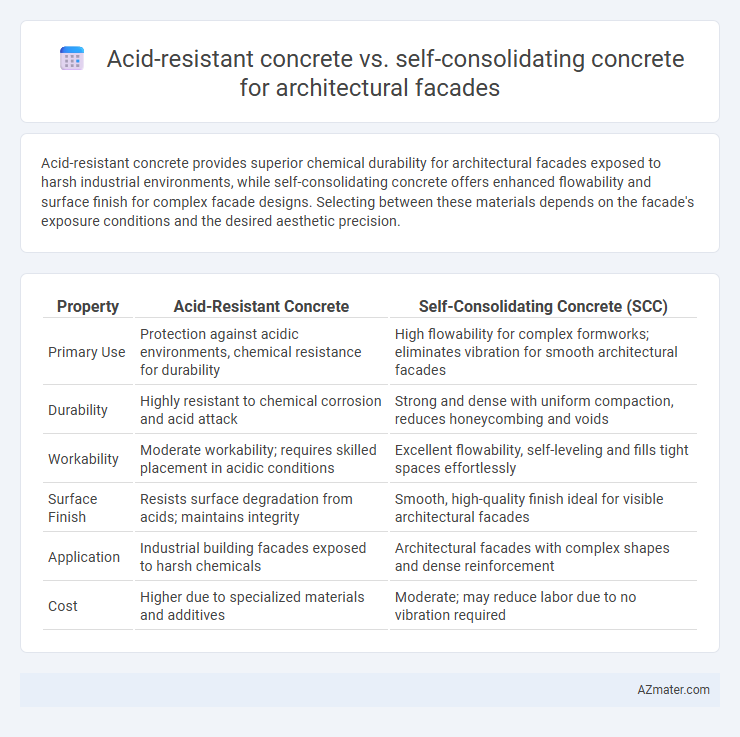Acid-resistant concrete provides superior chemical durability for architectural facades exposed to harsh industrial environments, while self-consolidating concrete offers enhanced flowability and surface finish for complex facade designs. Selecting between these materials depends on the facade's exposure conditions and the desired aesthetic precision.
Table of Comparison
| Property | Acid-Resistant Concrete | Self-Consolidating Concrete (SCC) |
|---|---|---|
| Primary Use | Protection against acidic environments, chemical resistance for durability | High flowability for complex formworks; eliminates vibration for smooth architectural facades |
| Durability | Highly resistant to chemical corrosion and acid attack | Strong and dense with uniform compaction, reduces honeycombing and voids |
| Workability | Moderate workability; requires skilled placement in acidic conditions | Excellent flowability, self-leveling and fills tight spaces effortlessly |
| Surface Finish | Resists surface degradation from acids; maintains integrity | Smooth, high-quality finish ideal for visible architectural facades |
| Application | Industrial building facades exposed to harsh chemicals | Architectural facades with complex shapes and dense reinforcement |
| Cost | Higher due to specialized materials and additives | Moderate; may reduce labor due to no vibration required |
Introduction to Specialized Concrete for Architectural Facades
Acid-resistant concrete is engineered to withstand harsh chemical environments, making it ideal for architectural facades exposed to industrial pollutants or acidic rain. Self-consolidating concrete offers superior flowability and vibration-free placement, enabling intricate shapes and smooth finishes essential for complex facade designs. Both types enhance durability and aesthetic quality but serve distinct roles based on environmental exposure and architectural complexity.
Understanding Acid-Resistant Concrete
Acid-resistant concrete is specifically engineered with chemical additives and aggregates to withstand harsh acidic environments, making it ideal for architectural facades exposed to industrial pollution or acid rain. Its enhanced durability against sulfuric and hydrochloric acids reduces surface degradation and extends the lifespan of exterior structures. Understanding the formulation and curing process of acid-resistant concrete is crucial for ensuring optimal performance and maintaining facade aesthetics under corrosive conditions.
Exploring Self-Consolidating Concrete (SCC)
Self-Consolidating Concrete (SCC) for architectural facades offers exceptional flowability and high-quality surface finishes, eliminating the need for mechanical vibration and reducing labor costs. Its ability to fill complex molds and intricate designs without segregation makes it ideal for creating aesthetically pleasing and durable building exteriors. Compared to acid-resistant concrete, SCC prioritizes ease of placement and surface texture over chemical resistance, making it a preferred choice for facades exposed to standard environmental conditions.
Key Material Properties Comparison
Acid-resistant concrete offers superior chemical durability with a low permeability matrix, effectively protecting architectural facades from acidic environments and industrial pollutants. Self-consolidating concrete enhances workability and surface finish due to its high flowability and segregation resistance, enabling intricate facade designs without mechanical vibration. While acid-resistant concrete prioritizes chemical stability and longevity, self-consolidating concrete excels in ease of placement and aesthetic precision, making material selection dependent on environmental exposure and design complexity.
Durability and Weather Resistance Factors
Acid-resistant concrete offers superior protection against chemical corrosion, making it ideal for architectural facades exposed to industrial pollutants and acidic rain, ensuring long-term durability. Self-consolidating concrete enhances weather resistance by providing high density and uniform compaction without vibration, reducing permeability and preventing water ingress that causes freeze-thaw damage. Both concretes improve facade longevity, but acid-resistant concrete specifically resists chemical attacks, while self-consolidating concrete excels in maintaining structural integrity under harsh environmental conditions.
Aesthetic Flexibility and Surface Finish
Acid-resistant concrete offers superior protection for architectural facades exposed to harsh chemical environments, ensuring long-term durability without compromising surface integrity, though its texture may be limited to standard finishes. Self-consolidating concrete enhances aesthetic flexibility by enabling intricate formwork and smooth, defect-free surfaces with high-quality finishes, ideal for complex facade designs. Selecting between these concretes depends on environmental exposure and design requirements, with acid-resistant concrete prioritizing durability and self-consolidating concrete maximizing visual appeal and surface refinement.
Installation Methods and Construction Efficiency
Acid-resistant concrete for architectural facades demands meticulous installation methods involving specialized formworks and curing processes to ensure chemical durability, often leading to longer construction timelines. Self-consolidating concrete (SCC) enhances construction efficiency by eliminating the need for vibration, allowing faster and more uniform placement especially in complex facade geometries. Comparing both, SCC reduces labor intensity and accelerates project completion, while acid-resistant concrete prioritizes longevity against chemical exposure with more controlled installation protocols.
Cost Considerations and Lifecycle Analysis
Acid-resistant concrete offers enhanced durability and protection against chemical corrosion, making it potentially more expensive upfront compared to self-consolidating concrete used in architectural facades. Self-consolidating concrete, known for its improved workability and reduced labor costs, can lower initial construction expenses but may require more frequent maintenance in chemically aggressive environments. Lifecycle analysis shows that while acid-resistant concrete involves higher initial investment, it often results in lower long-term repair and replacement costs due to its superior resistance to acid attack.
Environmental Impact and Sustainability
Acid-resistant concrete offers enhanced durability against chemical corrosion, reducing maintenance frequency and resource use, which contributes to long-term environmental sustainability in architectural facades. Self-consolidating concrete minimizes voids and defects, improving structural integrity and durability while reducing the need for repair and material waste, thus lessening its environmental footprint. Both concretes support sustainable construction by extending facade lifespan and optimizing resource efficiency, but acid-resistant concrete excels in hostile chemical environments, whereas self-consolidating concrete is preferable for complex designs with minimal labor and energy consumption.
Choosing the Right Concrete for Architectural Facades
Acid-resistant concrete offers superior durability against chemical corrosion, making it ideal for architectural facades exposed to industrial pollutants or acidic environments, while self-consolidating concrete excels in achieving smooth, intricate designs with minimal labor. Selecting the right concrete depends on environmental exposure and the desired facade aesthetics, where acid-resistant variants prioritize longevity and chemical protection, whereas self-consolidating concrete enhances formwork complexity and surface finish. Evaluating factors such as resistance to chemical agents, ease of placement, and visual appearance ensures optimal performance and durability for architectural facades.

Infographic: Acid-resistant concrete vs Self-consolidating concrete for Architectural facade
 azmater.com
azmater.com